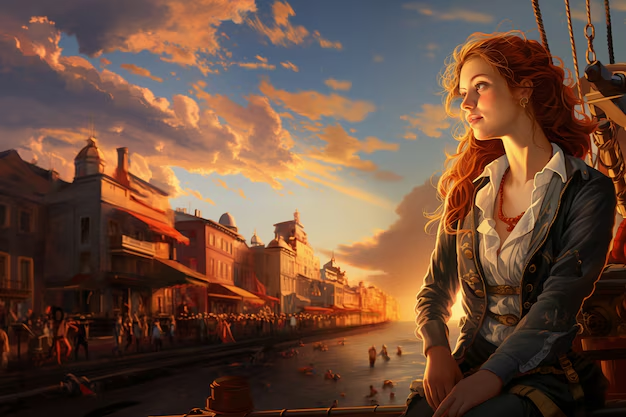The Regency Era, a captivating period in British history, stretches from 1811 to 1820, marked by the reign of George IV as Prince Regent. This era is renowned for its distinctive cultural, social, and political characteristics that continue to influence modern Britain. Dive into the world of the Regency Era, where elegance meets revolution, and discover what made this period so uniquely fascinating.
Historical Background
The Regency Era is nestled between the end of the Napoleonic Wars and the start of the Victorian Era. It began in 1811 when George IV, then the Prince Regent, assumed the role of acting monarch due to his father George III’s mental illness. This period saw significant transformations in British society, setting the stage for the 19th century’s rapid changes.
Political Landscape
The Regency Era was marked by considerable political activity and reform. The Prince Regent, George IV, wielded substantial influence, shaping policies and steering Britain through both domestic and international challenges. The era also saw the continuation of the Whig and Tory political rivalry, which would later evolve into the modern Conservative and Liberal parties.
Social Structure and Class
British society during the Regency Era was rigidly hierarchical, with clear distinctions between the upper class, middle class, and working class. The aristocracy enjoyed great wealth and power, while the emerging middle class began to assert their influence in politics and commerce. The period was characterized by social stratification, but it also laid the groundwork for future social mobility.
Fashion and Style
Regency fashion is iconic, known for its elegance and simplicity. Women wore empire-line dresses with high waistlines and light fabrics, reflecting classical Greco-Roman influences. Men’s fashion featured tailcoats, breeches, and cravats. This era’s fashion was not just about appearance but also about social status and refinement.
Cultural Developments
The Regency Era was a golden age for literature and the arts. It produced some of Britain’s most celebrated writers, including Jane Austen and Lord Byron. Austen’s novels, such as “Pride and Prejudice,” offer a window into the social mores of the time, while Byron’s poetry captures the era’s romantic spirit. The period also saw advancements in painting and music, contributing richly to the cultural tapestry of Britain.
Domestic Life and Family
Daily life during the Regency Era varied greatly depending on social class. For the upper classes, life was characterized by grand estates, social events, and elaborate household management. The middle class experienced more modest comforts, while the working class faced significant hardships. Family dynamics were often traditional, with clear roles for men and women.
Economics and Trade
The Regency Era was a time of economic growth and transformation. The industrial revolution was in full swing, leading to advancements in technology and industry. Trade expanded, and Britain’s empire continued to thrive, impacting global economics and solidifying Britain’s status as a major world power.
Architecture and Interior Design
Regency architecture is renowned for its grandeur and symmetry. Notable examples include the Regent’s Park and the Brighton Pavilion. Interior design of the time featured elegant furnishings, intricate wallpapers, and a focus on comfort and style, reflecting the era’s taste for opulence and refinement.
Education and Intellectual Life
Educational opportunities were expanding during the Regency Era, though access varied by class. The period saw the rise of educational reform and the establishment of new institutions. Intellectual life flourished with discussions on political and social reforms, influenced by Enlightenment ideas and scientific advancements.
Entertainment and Leisure
Leisure activities during the Regency Era were diverse. The upper classes enjoyed theatre, balls, and country estates, while the middle classes participated in social clubs and public entertainments. The period also saw the popularity of novels and music, reflecting the growing cultural appetite of the time.
Political and Social Reforms
The Regency Era was a time of significant reform, including the extension of voting rights and changes in social policies. These reforms addressed issues such as poverty, education, and the legal system, setting the stage for further progress in the Victorian Era.
Influence on Modern Culture
The Regency Era has left a lasting impact on modern culture, particularly through literature and media. Adaptations of Regency-era novels and films, such as adaptations of Jane Austen’s works, continue to captivate audiences. The era’s style and themes remain influential in contemporary fashion and cultural discourse.
Common Misconceptions
Despite its popularity, the Regency Era is often misunderstood. Common myths include the idea that everyone lived in luxury or that the era was entirely genteel. In reality, the period was marked by social tensions and economic disparities. Clarifying these misconceptions helps in understanding the era’s complexity.
Conclusion
The Regency Era was a transformative period in British history, characterized by political upheaval, cultural blossoming, and social change. Its influence can still be seen in modern culture, fashion, and literature. By exploring this fascinating period, we gain insight into how historical contexts shape our contemporary world.
FAQs
- What were the major events during the Regency Era?
Key events include the Napoleonic Wars, the War of 1812, and significant political and social reforms. - How did the Regency Era influence modern fashion?
Regency fashion has influenced contemporary styles, with its emphasis on elegance and simplicity continuing to inspire modern designers. - Who were the key figures of the Regency Era?
Prominent figures include George IV, Jane Austen, Lord Byron, and influential politicians like the Duke of Wellington. - What were common pastimes in Regency Britain?
Common pastimes included attending theatre performances, social gatherings, and participating in outdoor activities like horse riding. - How did the Regency Era impact British politics?
The period saw significant reforms and changes in political policies, laying the groundwork for modern British political structures.
Also Visit:
Understanding 180 Days from Today: A Comprehensive Guide
Ultimate Guide to Cloudflare Speed Test: Optimizing Your Web Performance



